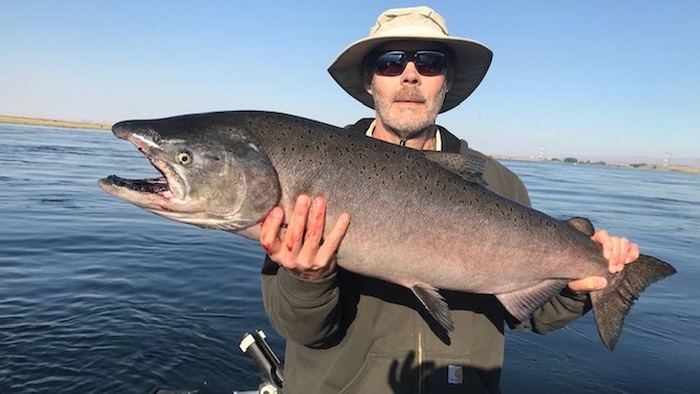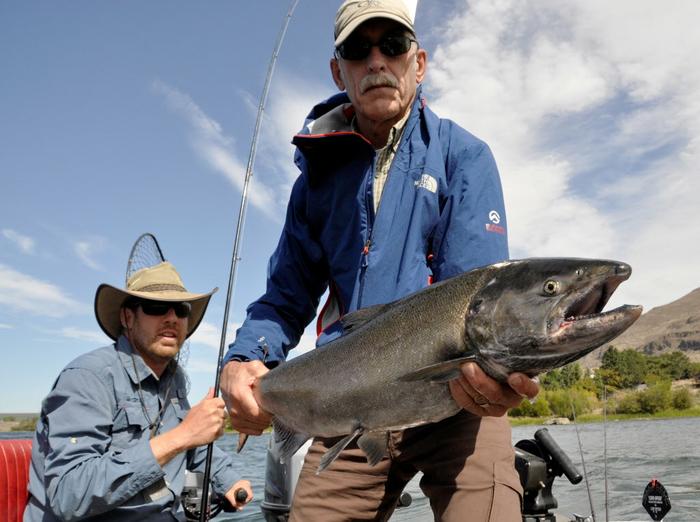forum
library
tutorial
contact

Did the Hanford Nuclear Site
Save Fall Chinook Salmon?
by Dennis Dauble
Spokesman-Review, October 5, 2022
|
the film forum library tutorial contact |

|
Did the Hanford Nuclear Site
by Dennis Dauble
|
"The number of dead salmon on the shores and floating in the river is incredible to Say."
-- October 1805 passage from the journals of Lewis and Clark

 This is not a story about the big one that got away or how to catch your limit, but the rarely told story how Cold War activities saved upriver runs of fall Chinook salmon from a bleak future.
This is not a story about the big one that got away or how to catch your limit, but the rarely told story how Cold War activities saved upriver runs of fall Chinook salmon from a bleak future.
Let’s start with local history.
Beginning in 1942, the Hanford site was selected by the U.S. government as the location for weapons-grade plutonium production reactors and associated processing facilities.
The area assured abundant water to cool reactor cores, electricity from the Grand Coulee power plant, and access to land that could be set aside to buffer the general public and enemy eyes.
Over the next two decades, nine reactors were built, each pumping heat and radioactive chemicals into the Columbia River. The first eight were shut down between 1964 and 1971, with the dual-purpose N-Reactor remaining in use until 1987.
A legacy of nuclear and chemical waste remains for future generations to deal with. Historically, the "three-river" (i.e., Yakima, Columbia, Snake) confluence was a major production area for fall Chinook salmon.
Consider an October 1805 passage from the journals of Lewis and Clark: "The number of dead salmon on the shores and floating in the river is incredible to Say."
These were not diseased fish, as the intrepid explorers thought, but spawned out Chinook salmon.
Indeed, much of the Columbia River, from the "Long Narrows" at The Dalles to the thunder of Kettle Falls, contained spawning habitat for ocean-type fall Chinook salmon.
That is, until the construction of four lower Columbia River dams from 1938 to 1968, and five upriver dams from 1933 to 1967. These well calculated hydroelectric projects flooded ancient fishing falls and turned the river upstream of Bonneville Dam, save for the 50-mile-long Hanford Reach, into a series of slow-moving reservoirs.
Scientists were well aware of impacts to salmon at the time, but they were also optimistic (and ignorant) of the outcome. Their idea was upriver salmon runs could be replaced with hatchery fish and increased production in downstream tributaries, such as the Wenatchee River.
Before that, upriver salmon runs had been severely depleted due to an overzealous commercial harvest that peaked in 1882. Numbers of salmon returning to the Columbia River had declined to a small fraction of historical numbers when the first spawning surveys took place in the Hanford Reach.
Over the next decade, the number of redds or spawning nests ranged from only 62 to 787 per year.
Fall Chinook salmon runs in the Snake River were on a downward slide because of Brownlee, Oxbow, and impassable Hells Canyon Dam when the last of the four lower Snake River dams became operational.
After the gates to Priest Rapids, Wanapum, and Ice Harbor Dams closed, the Hanford Reach became one of but a few locations in the entire Columbia River Basin where abundant gravel and adequate flow provided spawning and rearing habitat for fall Chinook salmon.
The number of spawning pairs in the Reach increased dramatically over the next few decades because salmon had no place else to go.
Columbia River salmon populations were in jeopardy once again in 1978 when the U.S. Army Corps of Engineers resurrected the Ben Franklin Dam project.
A proposed run-of-the-river, low-head structure at River Mile 348 would raise the river water surface about 59 feet at normal pool elevation and 36,000 cubic feet per second flow.
Plans were finally abandoned in 1981 after overwhelming opposition. Obviously, the dam would eliminate the last spawning refuge for fall Chinook salmon.
Perhaps more telling was concern flooded backwaters would increase the rate of movement of hazardous materials from Hanford’s underground waste storage sites into the Columbia River.
So where are we today?
Cleanup of past toxic and radioactive waste at the Hanford site is ongoing and will continue for decades.
The Hanford Reach, albeit constrained by regulated flows from upstream storage projects, retains many of the characteristics of a natural river. Designated a National Monument in 2000, protection from future development appears ensured.
The Priest Rapids hatchery, built as mitigation for dam operations, releases as many as 5 to 10 million juvenile fall Chinook salmon each year to supplement the natural spawning population.
According to WDFW, adult returns of fall Chinook (hatchery + natural origin) to the Hanford Reach have ranged from 68,517 (2018) to 341,501 (2015) over the past 10 years.
This word-class fishery attracts hundreds of anglers every fall and bolsters the revenue of local tackle shops, restaurants and hotels.
So, did past Hanford activities save Columbia River salmon?
The terms "ironic" and "paradoxical" have been used to describe how public concern over the release of legacy wastes to the environment derailed plans to build Ben Franklin Dam.
No matter how you slice it, sportsmen, the general public and our beloved orca benefited from the decision.
Related Pages:
Fall Chinook Stampede Toward Hanford Reach by Rich Landers, Spokesman-Review, 9/11/14
Fall Chinook Hitting at Snake-Clearwater Confluence by Rich Landers, Spokesman-Review, 9/17/14
learn more on topics covered in the film
see the video
read the script
learn the songs
discussion forum
